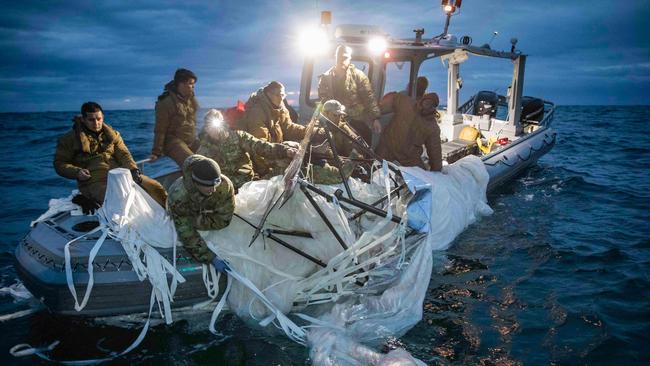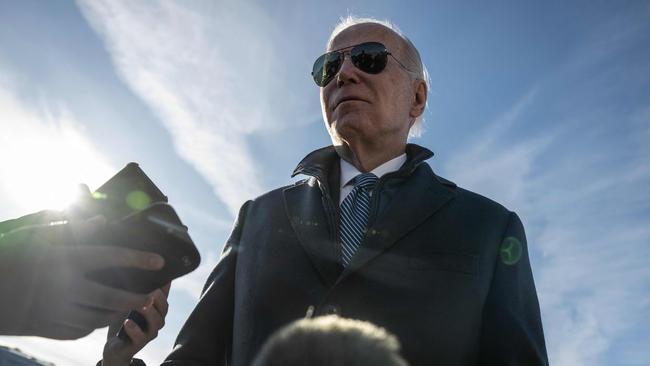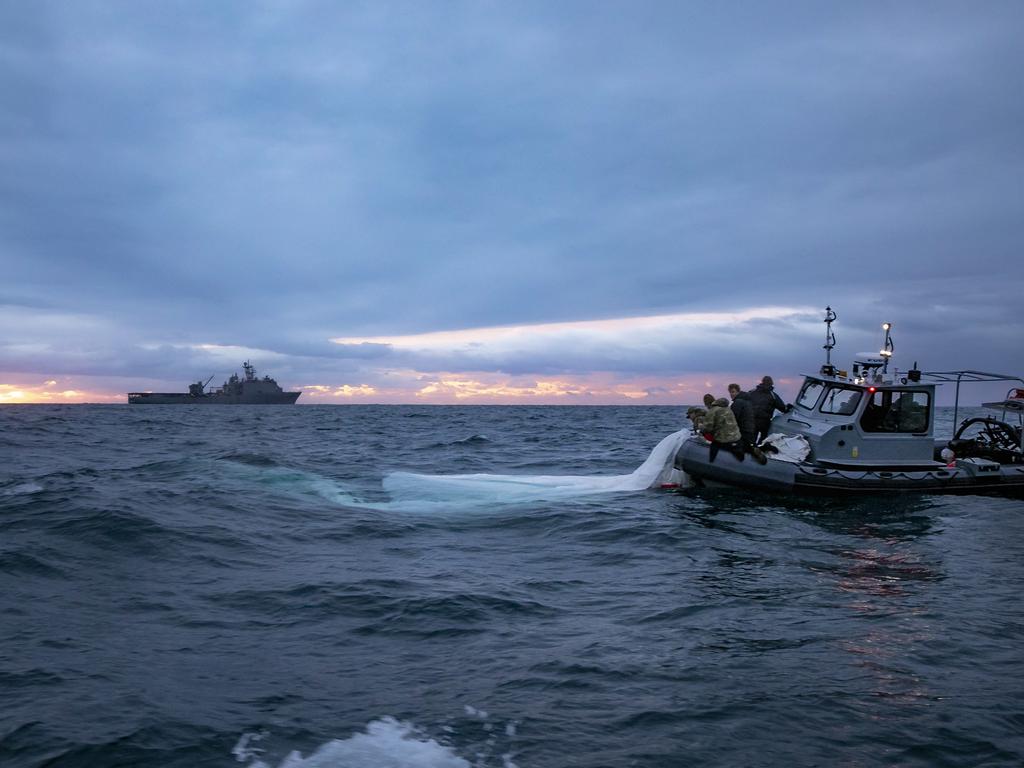Chinese balloon carried antennas, other equipment to gather intelligence, US says
The Biden administration will take action against companies and entities linked to Beijing’s program the US says has spied on more than 40 countries across five continents.

The Chinese balloon that crossed the US carried antennas and sensors for collecting intelligence and communications, administration officials said, laying out the most detailed evidence to date about China’s surveillance program.
The new information was described Thursday by a range of officials from the Pentagon, State Department and FBI as the Biden administration prepared to take unspecified action against companies and entities linked to the Chinese balloon program that the US says has spied on more than 40 countries across five continents.
Much of the information came from tracking the balloon over eight days as it traversed the US last week before being shot down off the Atlantic coast Saturday. Images captured by high-altitude U-2 surveillance planes showed that the balloon was equipped with multiple antennas, including an array likely capable of pinpointing the location of communications, a senior State Department official said.
Those U-2 and other reconnaissance flights also found that the balloon carried large solar panels capable of powering an array of intelligence collection sensors. The manufacturer of the balloon has a direct relationship with the Chinese military, the State Department official said.

More information is expected in coming days as personnel from the Federal Bureau of Investigation examine components of the surveillance equipment that are being retrieved from the waters near the coast of South Carolina. Around noon Thursday, the Navy suspended the use of divers in the search due to weather, and the delay, a defence official said, could last into the weekend.
By providing detailed information, the administration is trying to buttress its case that the craft was designed for high-altitude spying, not as China said, for civilian weather research. It is also trying to dispel criticism from Congress about its handling of the balloon.
The House, controlled by a Republican majority whose members have criticised the administration over the balloon, passed a resolution 419-0 Thursday condemning China for its “brazen violation of United States sovereignty” and called on the White House to provide more information.
Much of the congressional focus was on what steps the Pentagon planned to take in the future to prevent further incursions and why the balloon wasn’t shot down as it passed over the Aleutian Islands on Jan. 28 and then over other parts of Alaska the next day.
Administration officials briefed members of Congress in open and closed-door hearings. Pentagon officials, in testimony to a Senate Appropriations subcommittee on defence, said that the balloon wasn’t deemed to be a threat as it crossed Alaska where it didn’t pass over sensitive sites in Alaska.
They added that no analysis had been done at that point on where the debris from the Chinese craft might fall. They emphasised that the balloon was 200 feet tall and carried an equipment array that was the size of a small airplane.

Shooting down the balloon in the waters off Alaska would likely have made recovering it more difficult due to the depth and frigid ocean temperatures, said Melissa Dalton, a senior Pentagon official with responsibilities for homeland defence.
Lt. Gen. Douglas Sims II, director of operations for the Pentagon’s Joint Staff, cautioned that shooting down an intruding craft not seen as an imminent threat might encourage other nations to act hastily if Western planes approached their borders.
“Once you take a shot, you can’t get it back,” Gen. Sims said. “I think it’s important for us to remember that if we establish that precedent … we may meet the same precedent.” “We may create something that is to our detriment,” he added. The US has conducted reconnaissance flights in international airspace close to China’s territorial limits, drawing frequent objections from Beijing. In December, a Chinese J-11 fighter flew within 20 feet of a US RC-135 surveillance plane near South China Sea islands controlled by Beijing.
The Pentagon testimony didn’t assuage some lawmakers, particularly Sen. Lisa Murkowski, a Republican from Alaska. Ms Murkowski said that the Pentagon appeared to be treating potential threats to her state as a secondary concern.
“At what point do we say a surveillance balloon, a spy balloon coming from China is a threat to our sovereignty?” she said. ” It should be the minute it crosses the line, and that line is Alaska.
Sen. Jon Tester (D., Mont.) said that the Congress expected the Biden administration to propose new spending and initiatives to fill the gaps in its radar coverage and prevent another balloon intrusion.
Pentagon officials described the current program to upgrade the radar capabilities of the North American Aerospace Defense Command, the joint-US Canada organisation known as Norad, but didn’t outline new initiatives.
The administration has said it was aware of at least four prior incursions over US airspace, including three during the Trump administration. Those flights were much shorter in duration and weren’t detected by Norad when they occurred. US intelligence later determined the flights had taken place and told Norad about them, officials have said.
US officials expect to learn more about the balloon’s capabilities from the forensic examination the FBI is conducting of the debris. FBI personnel have so far only examined the balloon canopy, some wiring and a small amount of electronics, senior FBI officials told reporters Thursday.

The agency is still waiting to process the largest part of the equipment slung under the balloon that likely housed most of the electronics, one of the officials said. The agency has started transporting items to the FBI’s lab at Quantico, Va., to remove the saltwater and process them for further study, the officials said.
On Wednesday, the fifth day of the search effort, the Navy found additional scaffolding and electronics part of that equipment package.
The State Department official said that the US was exploring possible action against the government-linked entities involved in China’s balloon and broader surveillance programs. According to two US officials, the Biden administration is looking to add about six Chinese government-backed companies with links to the balloon program to the Commerce Department’s entities list, which imposes barriers to conducting business with the black-listed firms.
The timing of that action wasn’t immediately clear, the officials said. However, the objective of any retaliatory measures, according to the State Department official, is to expose and address China’s broader surveillance activities.
The balloon’s manufacturer, according to the senior official, has direct links to the Chinese military and is an “approved vendor” of the People’s Liberation Army, as is evidenced by information published in an official procurement portal for the PLA.
“The company also advertises balloon products on its website and hosts videos from past flights, which appear to have overflown at least US airspace and airspace of other countries,” the official said. “These advertised balloon videos seemingly have similar flight patterns as the balloons we have been discussing this week.”
The Wall Street Journal







To join the conversation, please log in. Don't have an account? Register
Join the conversation, you are commenting as Logout